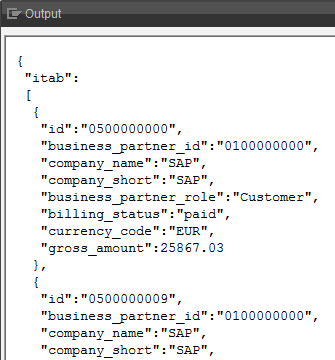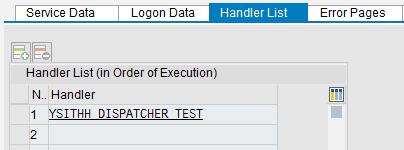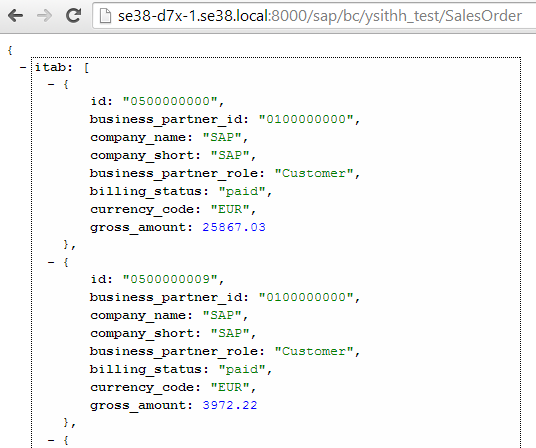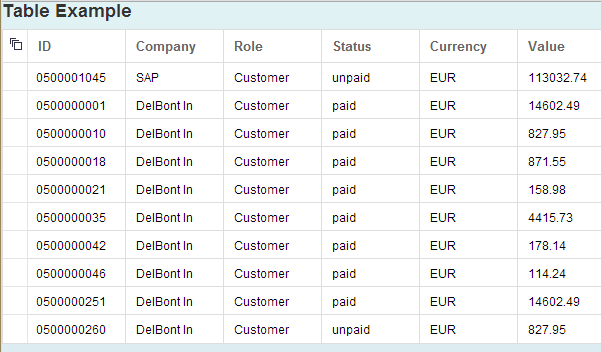
- SAP Community
- Products and Technology
- Technology
- Technology Blogs by Members
- #sitHH : Exposing data to #UI5 without using SAP G...
- Subscribe to RSS Feed
- Mark as New
- Mark as Read
- Bookmark
- Subscribe
- Printer Friendly Page
- Report Inappropriate Content
This year, just a week before I've started my wonderful vacations in Barcelona and Alcúdia, I had again the pleasure to hold a session at SAP Inside Track Hamburg. Because I'm not able to provide the slides (I haven't used any) I was asked to blog about it. (to satisfy someone: this means to "write a blog post" :wink: )
The Motivation
One of my current customers is implementing a new E-commerce shop and I'm responsible for the connection to the backend SAP ERP system. "Yea, again a SAP Gateway project" just came into my mind as soon as I've heard about it 🙂 A quick look into "System -> Status" and I realized that they are on ERP 6.0 Ehp 0 (Zero) -> no Gateway installed.
The Options
- upgrade the system to a higher Enhancement Package so SAP GW is part of the standard installation
- install SAP GW as Add-On
- something completely different
Option 1.) was completely out of budget. Sure, they have to do it sometimes in the near future, but not now and not for this reason.
For option 2.) a question came into my mind, which I was not able to answer: what happens in a later EHP upgrade, where SAP GW is part of the standard, if we already had installed SAP GW as Add-On? Will we get into trouble?
The Solution
If you know a bit of my background (I'm a little RESTifarian ), you will not be surprised that I've choosen ADL (Alternative Dispatcher Layer, by dj.adams ) and zJSON (ABAP JSON document class, by me) to solve this problem. Open Source #ftw ! Links: see Appendix
SAP's new claim is "SIMPLE". And yes: ADL + zJSON is simple. It's so simple, that I'm using it even for prototyping if SAP GW IS installed (because ie. the cleansing behind you is much easier).
Edit: please concider that you need an additional user license for the (anonymous) ICF user.
The Data
To make the demo a bit (more) interesting, I've used a DDL view instead of a table as data source:
@AbapCatalog.sqlViewName: 'YSITHH_SO'
define view ysitHHSalesOrder as select from snwd_so as so
inner join snwd_bpa as bpa on so.buyer_guid = bpa.node_key {
key so.so_id as id,
bpa.bp_id as business_partner_id,
bpa.company_name,
substring( bpa.company_name, 1, 10 ) as company_short,
case bpa.bp_role
when '01' then 'Customer'
when '02' then 'Supplier'
else 'undefined'
end as business_partner_role,
case so.billing_status
when ' ' then 'unpaid'
else 'paid'
end as billing_status,
@Semantics.currencyCode so.currency_code,
@Semantics.amount.currencyCode: 'currency_code' so.gross_amount
}
(for documentation link on DDL sources and the new openSQL syntax, see Appendix)
Test report
DATA salesorders TYPE STANDARD TABLE OF ysithhsalesorder.
SELECT * FROM ysithhsalesorder
INTO TABLE @salesorders.
cl_demo_output=>display( salesorders ).
Result

The JSON document
To translate the data in JSON format I've used my JSON document class.
DATA salesorders TYPE STANDARD TABLE OF ysithhsalesorder.
SELECT * FROM ysithhsalesorder
INTO TABLE @salesorders.
cl_demo_output=>display_json( zcl_json_document=>create_with_data( salesorders )->get_json( ) ).
(you've noticed the method chaining? I like it. But don't overuse it, please)
Result

The Call
Now to the REST call: the ADL implementation.
We have to create the REST dispatcher (or use an existing one) and the REST resource for the order data.
The Dispatcher
CLASS ysithh_dispatcher_test DEFINITION
PUBLIC
INHERITING FROM y_adl_disp_base
FINAL
CREATE PUBLIC .
PUBLIC SECTION.
METHODS if_http_extension~handle_request REDEFINITION.
PROTECTED SECTION.
PRIVATE SECTION.
ENDCLASS.
CLASS YSITHH_DISPATCHER_TEST IMPLEMENTATION.
METHOD if_http_extension~handle_request.
handler( p = '^/SalesOrder' h = 'YSITHH_SALESORDER_TEST' ).
dispatch( server ).
ENDMETHOD.
ENDCLASS.
Don't forget to enter the dispatcher class into the ICF path via transaction SICF


The Resource
CLASS ysithh_salesorder_test DEFINITION
PUBLIC
INHERITING FROM y_adl_res_base
FINAL
CREATE PUBLIC .
PUBLIC SECTION.
METHODS get
IMPORTING matches TYPE stringtab.
PROTECTED SECTION.
PRIVATE SECTION.
ENDCLASS.
CLASS ysithh_salesorder_test IMPLEMENTATION.
METHOD get.
DATA salesorder TYPE STANDARD TABLE OF ysithhsalesorder.
SELECT * FROM ysithhsalesorder
INTO TABLE @salesorder.
response->set_cdata( zcl_json_document=>create_with_data( salesorder )->get_json( ) ).
response->set_header_field(
EXPORTING
name = 'Access-Control-Allow-Origin' " Name of the header field
value = '*' " HTTP header field value
).
ENDMETHOD.
ENDCLASS.
The Test
For a test of the service just call the resource in a browser of your choice: http://host:port/sap/bc/ysithh_test/SalesOrder
Viewed with Chrome plug-in "JSONview"

The App
Now we are able to consume the data for example in an UI5 table.
index.html
<!DOCTYPE HTML>
<html>
<head>
<meta http-equiv="X-UA-Compatible" content="IE=edge">
<meta http-equiv='Content-Type' content='text/html;charset=UTF-8'/>
<script src="resources/sap-ui-core.js"
id="sap-ui-bootstrap"
data-sap-ui-libs="sap.ui.commons"
data-sap-ui-theme="sap_bluecrystal">
</script>
<!-- add sap.ui.table,sap.ui.ux3 and/or other libraries to 'data-sap-ui-libs' if required -->
<script>
sap.ui.localResources("sithh_test");
var view = sap.ui.view({id:"idmain1", viewName:"sithh_test.main", type:sap.ui.core.mvc.ViewType.XML});
view.placeAt("content");
</script>
</head>
<body class="sapUiBody" role="application">
<div id="content"></div>
</body>
</html>
main.view.xml
<core:View xmlns:core="sap.ui.core"
xmlns:mvc="sap.ui.core.mvc"
xmlns:commons="sap.ui.commons"
xmlns:m="sap.m"
xmlns="sap.ui.table"
controllerName="sithh_test.main" xmlns:html="http://www.w3.org/1999/xhtml">
<Table
id="tt"
rows="{/itab}"
title="Table Example">
<columns>
<Column>
<label>
<commons:Label text="ID" />
</label>
<template>
<commons:TextField value="{id}" />
</template>
</Column>
<Column>
<label>
<commons:Label text="Company" />
</label>
<template>
<commons:TextField value="{company_short}" />
</template>
</Column>
<Column>
<label>
<commons:Label text="Role" />
</label>
<template>
<commons:TextField value="{business_partner_role}" />
</template>
</Column>
<Column>
<label>
<commons:Label text="Status" />
</label>
<template>
<commons:TextField value="{billing_status}" />
</template>
</Column>
<Column>
<label>
<commons:Label text="Currency" />
</label>
<template>
<commons:TextField value="{currency_code}" />
</template>
</Column>
<Column>
<label>
<commons:Label text="Value" />
</label>
<template>
<commons:TextField value="{gross_amount}" />
</template>
</Column>
</columns>
</Table>
</core:View>
main.controller.js
sap.ui.controller("sithh_test.main", {
onInit: function() {
var oModel = new sap.ui.model.json.JSONModel(
'http://se38-d7x-1.se38.local:8000/sap/bc/ysithh_test/SalesOrder'
);
sap.ui.getCore().setModel(oModel);
},
});
The Result

Appendix
If you wonder: SAP has changed the name of "SAP Netweaver Gateway". It is now just "SAP Gateway"
ADL
Source: https://github.com/qmacro/ADL
Documentation: http://scn.sap.com/people/dj.adams/blog/2009/09/21/a-new-rest-handler-dispatcher-for-the-icf
JSON Document Class
Source: https://github.com/se38/zJSON/wiki/Usage-zJSON
Open UI5
http://sap.github.io/openui5/
DDL
http://scn.sap.com/community/abap/eclipse/blog/2014/02/04/new-data-modeling-features-in-abap-for-han...
New Open SQL Syntax
http://help.sap.com/abapdocu_740/en/index.htm?file=ABENNEWS-740_SP05-OPEN_SQL.htm
You can reach me via Twitter or G+
- SAP Managed Tags:
- ABAP Development,
- SAP Gateway,
- NW ABAP Gateway (OData)
You must be a registered user to add a comment. If you've already registered, sign in. Otherwise, register and sign in.
-
"automatische backups"
1 -
"regelmäßige sicherung"
1 -
505 Technology Updates 53
1 -
ABAP
14 -
ABAP API
1 -
ABAP CDS Views
2 -
ABAP CDS Views - BW Extraction
1 -
ABAP CDS Views - CDC (Change Data Capture)
1 -
ABAP class
2 -
ABAP Cloud
2 -
ABAP Development
5 -
ABAP in Eclipse
1 -
ABAP Platform Trial
1 -
ABAP Programming
2 -
abap technical
1 -
access data from SAP Datasphere directly from Snowflake
1 -
Access data from SAP datasphere to Qliksense
1 -
Accrual
1 -
action
1 -
adapter modules
1 -
Addon
1 -
Adobe Document Services
1 -
ADS
1 -
ADS Config
1 -
ADS with ABAP
1 -
ADS with Java
1 -
ADT
2 -
Advance Shipping and Receiving
1 -
Advanced Event Mesh
3 -
AEM
1 -
AI
7 -
AI Launchpad
1 -
AI Projects
1 -
AIML
9 -
Alert in Sap analytical cloud
1 -
Amazon S3
1 -
Analytical Dataset
1 -
Analytical Model
1 -
Analytics
1 -
Analyze Workload Data
1 -
annotations
1 -
API
1 -
API and Integration
3 -
API Call
2 -
Application Architecture
1 -
Application Development
5 -
Application Development for SAP HANA Cloud
3 -
Applications and Business Processes (AP)
1 -
Artificial Intelligence
1 -
Artificial Intelligence (AI)
4 -
Artificial Intelligence (AI) 1 Business Trends 363 Business Trends 8 Digital Transformation with Cloud ERP (DT) 1 Event Information 462 Event Information 15 Expert Insights 114 Expert Insights 76 Life at SAP 418 Life at SAP 1 Product Updates 4
1 -
Artificial Intelligence (AI) blockchain Data & Analytics
1 -
Artificial Intelligence (AI) blockchain Data & Analytics Intelligent Enterprise
1 -
Artificial Intelligence (AI) blockchain Data & Analytics Intelligent Enterprise Oil Gas IoT Exploration Production
1 -
Artificial Intelligence (AI) blockchain Data & Analytics Intelligent Enterprise sustainability responsibility esg social compliance cybersecurity risk
1 -
ASE
1 -
ASR
2 -
ASUG
1 -
Attachments
1 -
Authorisations
1 -
Automating Processes
1 -
Automation
1 -
aws
2 -
Azure
1 -
Azure AI Studio
1 -
B2B Integration
1 -
Backorder Processing
1 -
Backup
1 -
Backup and Recovery
1 -
Backup schedule
1 -
BADI_MATERIAL_CHECK error message
1 -
Bank
1 -
BAS
1 -
basis
2 -
Basis Monitoring & Tcodes with Key notes
2 -
Batch Management
1 -
BDC
1 -
Best Practice
1 -
bitcoin
1 -
Blockchain
3 -
BOP in aATP
1 -
BOP Segments
1 -
BOP Strategies
1 -
BOP Variant
1 -
BPC
1 -
BPC LIVE
1 -
BTP
11 -
BTP Destination
2 -
Business AI
1 -
Business and IT Integration
1 -
Business application stu
1 -
Business Architecture
1 -
Business Communication Services
1 -
Business Continuity
1 -
Business Data Fabric
3 -
Business Partner
12 -
Business Partner Master Data
10 -
Business Technology Platform
2 -
Business Trends
1 -
CA
1 -
calculation view
1 -
CAP
2 -
Capgemini
1 -
Catalyst for Efficiency: Revolutionizing SAP Integration Suite with Artificial Intelligence (AI) and
1 -
CCMS
2 -
CDQ
12 -
CDS
2 -
Cental Finance
1 -
Certificates
1 -
CFL
1 -
Change Management
1 -
chatbot
1 -
chatgpt
3 -
CL_SALV_TABLE
2 -
Class Runner
1 -
Classrunner
1 -
Cloud ALM Monitoring
1 -
Cloud ALM Operations
1 -
cloud connector
1 -
Cloud Extensibility
1 -
Cloud Foundry
3 -
Cloud Integration
6 -
Cloud Platform Integration
2 -
cloudalm
1 -
communication
1 -
Compensation Information Management
1 -
Compensation Management
1 -
Compliance
1 -
Compound Employee API
1 -
Configuration
1 -
Connectors
1 -
Conversion
1 -
Cosine similarity
1 -
cryptocurrency
1 -
CSI
1 -
ctms
1 -
Custom chatbot
3 -
Custom Destination Service
1 -
custom fields
1 -
Customer Experience
1 -
Customer Journey
1 -
Customizing
1 -
Cyber Security
2 -
Data
1 -
Data & Analytics
1 -
Data Aging
1 -
Data Analytics
2 -
Data and Analytics (DA)
1 -
Data Archiving
1 -
Data Back-up
1 -
Data Governance
5 -
Data Integration
2 -
Data Quality
12 -
Data Quality Management
12 -
Data Synchronization
1 -
data transfer
1 -
Data Unleashed
1 -
Data Value
8 -
database tables
1 -
Datasphere
2 -
datenbanksicherung
1 -
dba cockpit
1 -
dbacockpit
1 -
Debugging
2 -
Delimiting Pay Components
1 -
Delta Integrations
1 -
Destination
3 -
Destination Service
1 -
Developer extensibility
1 -
Developing with SAP Integration Suite
1 -
Devops
1 -
Digital Transformation
1 -
Documentation
1 -
Dot Product
1 -
DQM
1 -
dump database
1 -
dump transaction
1 -
e-Invoice
1 -
E4H Conversion
1 -
Eclipse ADT ABAP Development Tools
2 -
edoc
1 -
edocument
1 -
ELA
1 -
Embedded Consolidation
1 -
Embedding
1 -
Embeddings
1 -
Employee Central
1 -
Employee Central Payroll
1 -
Employee Central Time Off
1 -
Employee Information
1 -
Employee Rehires
1 -
Enable Now
1 -
Enable now manager
1 -
endpoint
1 -
Enhancement Request
1 -
Enterprise Architecture
1 -
ETL Business Analytics with SAP Signavio
1 -
Euclidean distance
1 -
Event Dates
1 -
Event Driven Architecture
1 -
Event Mesh
2 -
Event Reason
1 -
EventBasedIntegration
1 -
EWM
1 -
EWM Outbound configuration
1 -
EWM-TM-Integration
1 -
Existing Event Changes
1 -
Expand
1 -
Expert
2 -
Expert Insights
1 -
Fiori
14 -
Fiori Elements
2 -
Fiori SAPUI5
12 -
Flask
1 -
Full Stack
8 -
Funds Management
1 -
General
1 -
Generative AI
1 -
Getting Started
1 -
GitHub
8 -
Grants Management
1 -
groovy
1 -
GTP
1 -
HANA
5 -
HANA Cloud
2 -
Hana Cloud Database Integration
2 -
HANA DB
1 -
HANA XS Advanced
1 -
Historical Events
1 -
home labs
1 -
HowTo
1 -
HR Data Management
1 -
html5
8 -
idm
1 -
Implementation
1 -
input parameter
1 -
instant payments
1 -
integration
3 -
Integration Advisor
1 -
Integration Architecture
1 -
Integration Center
1 -
Integration Suite
1 -
intelligent enterprise
1 -
Java
1 -
job
1 -
Job Information Changes
1 -
Job-Related Events
1 -
Job_Event_Information
1 -
joule
4 -
Journal Entries
1 -
Just Ask
1 -
Kerberos for ABAP
8 -
Kerberos for JAVA
8 -
Launch Wizard
1 -
Learning Content
2 -
Life at SAP
1 -
lightning
1 -
Linear Regression SAP HANA Cloud
1 -
local tax regulations
1 -
LP
1 -
Machine Learning
2 -
Marketing
1 -
Master Data
3 -
Master Data Management
14 -
Maxdb
2 -
MDG
1 -
MDGM
1 -
MDM
1 -
Message box.
1 -
Messages on RF Device
1 -
Microservices Architecture
1 -
Microsoft Universal Print
1 -
Middleware Solutions
1 -
Migration
5 -
ML Model Development
1 -
Modeling in SAP HANA Cloud
8 -
Monitoring
3 -
MTA
1 -
Multi-Record Scenarios
1 -
Multiple Event Triggers
1 -
Neo
1 -
New Event Creation
1 -
New Feature
1 -
Newcomer
1 -
NodeJS
1 -
ODATA
2 -
OData APIs
1 -
odatav2
1 -
ODATAV4
1 -
ODBC
1 -
ODBC Connection
1 -
Onpremise
1 -
open source
2 -
OpenAI API
1 -
Oracle
1 -
PaPM
1 -
PaPM Dynamic Data Copy through Writer function
1 -
PaPM Remote Call
1 -
PAS-C01
1 -
Pay Component Management
1 -
PGP
1 -
Pickle
1 -
PLANNING ARCHITECTURE
1 -
Popup in Sap analytical cloud
1 -
PostgrSQL
1 -
POSTMAN
1 -
Process Automation
2 -
Product Updates
4 -
PSM
1 -
Public Cloud
1 -
Python
4 -
Qlik
1 -
Qualtrics
1 -
RAP
3 -
RAP BO
2 -
Record Deletion
1 -
Recovery
1 -
recurring payments
1 -
redeply
1 -
Release
1 -
Remote Consumption Model
1 -
Replication Flows
1 -
Research
1 -
Resilience
1 -
REST
1 -
REST API
1 -
Retagging Required
1 -
Risk
1 -
Rolling Kernel Switch
1 -
route
1 -
rules
1 -
S4 HANA
1 -
S4 HANA Cloud
1 -
S4 HANA On-Premise
1 -
S4HANA
3 -
S4HANA_OP_2023
2 -
SAC
10 -
SAC PLANNING
9 -
SAP
4 -
SAP ABAP
1 -
SAP Advanced Event Mesh
1 -
SAP AI Core
8 -
SAP AI Launchpad
8 -
SAP Analytic Cloud Compass
1 -
Sap Analytical Cloud
1 -
SAP Analytics Cloud
4 -
SAP Analytics Cloud for Consolidation
1 -
SAP Analytics Cloud Story
1 -
SAP analytics clouds
1 -
SAP BAS
1 -
SAP Basis
6 -
SAP BODS
1 -
SAP BODS certification.
1 -
SAP BTP
20 -
SAP BTP Build Work Zone
2 -
SAP BTP Cloud Foundry
5 -
SAP BTP Costing
1 -
SAP BTP CTMS
1 -
SAP BTP Innovation
1 -
SAP BTP Migration Tool
1 -
SAP BTP SDK IOS
1 -
SAP Build
11 -
SAP Build App
1 -
SAP Build apps
1 -
SAP Build CodeJam
1 -
SAP Build Process Automation
3 -
SAP Build work zone
10 -
SAP Business Objects Platform
1 -
SAP Business Technology
2 -
SAP Business Technology Platform (XP)
1 -
sap bw
1 -
SAP CAP
1 -
SAP CDC
1 -
SAP CDP
1 -
SAP Certification
1 -
SAP Cloud ALM
4 -
SAP Cloud Application Programming Model
1 -
SAP Cloud Integration for Data Services
1 -
SAP cloud platform
8 -
SAP Companion
1 -
SAP CPI
3 -
SAP CPI (Cloud Platform Integration)
2 -
SAP CPI Discover tab
1 -
sap credential store
1 -
SAP Customer Data Cloud
1 -
SAP Customer Data Platform
1 -
SAP Data Intelligence
1 -
SAP Data Services
1 -
SAP DATABASE
1 -
SAP Dataspher to Non SAP BI tools
1 -
SAP Datasphere
9 -
SAP DRC
1 -
SAP EWM
1 -
SAP Fiori
2 -
SAP Fiori App Embedding
1 -
Sap Fiori Extension Project Using BAS
1 -
SAP GRC
1 -
SAP HANA
1 -
SAP HCM (Human Capital Management)
1 -
SAP HR Solutions
1 -
SAP IDM
1 -
SAP Integration Suite
9 -
SAP Integrations
4 -
SAP iRPA
2 -
SAP Learning Class
1 -
SAP Learning Hub
1 -
SAP Odata
2 -
SAP on Azure
1 -
SAP PartnerEdge
1 -
sap partners
1 -
SAP Password Reset
1 -
SAP PO Migration
1 -
SAP Prepackaged Content
1 -
SAP Process Automation
2 -
SAP Process Integration
2 -
SAP Process Orchestration
1 -
SAP S4HANA
2 -
SAP S4HANA Cloud
1 -
SAP S4HANA Cloud for Finance
1 -
SAP S4HANA Cloud private edition
1 -
SAP Sandbox
1 -
SAP STMS
1 -
SAP SuccessFactors
2 -
SAP SuccessFactors HXM Core
1 -
SAP Time
1 -
SAP TM
2 -
SAP Trading Partner Management
1 -
SAP UI5
1 -
SAP Upgrade
1 -
SAP-GUI
8 -
SAP_COM_0276
1 -
SAPBTP
1 -
SAPCPI
1 -
SAPEWM
1 -
sapmentors
1 -
saponaws
2 -
SAPUI5
4 -
schedule
1 -
Secure Login Client Setup
8 -
security
9 -
Selenium Testing
1 -
SEN
1 -
SEN Manager
1 -
service
1 -
SET_CELL_TYPE
1 -
SET_CELL_TYPE_COLUMN
1 -
SFTP scenario
2 -
Simplex
1 -
Single Sign On
8 -
Singlesource
1 -
SKLearn
1 -
soap
1 -
Software Development
1 -
SOLMAN
1 -
solman 7.2
2 -
Solution Manager
3 -
sp_dumpdb
1 -
sp_dumptrans
1 -
SQL
1 -
sql script
1 -
SSL
8 -
SSO
8 -
SuccessFactors
1 -
SuccessFactors Time Tracking
1 -
Sybase
1 -
system copy method
1 -
System owner
1 -
Table splitting
1 -
Tax Integration
1 -
Technical article
1 -
Technical articles
1 -
Technology Updates
1 -
Technology Updates
1 -
Technology_Updates
1 -
Threats
1 -
Time Collectors
1 -
Time Off
2 -
Tips and tricks
2 -
Tools
1 -
Trainings & Certifications
1 -
Transport in SAP BODS
1 -
Transport Management
1 -
TypeScript
1 -
unbind
1 -
Unified Customer Profile
1 -
UPB
1 -
Use of Parameters for Data Copy in PaPM
1 -
User Unlock
1 -
VA02
1 -
Vector Database
1 -
Vector Engine
1 -
Visual Studio Code
1 -
VSCode
1 -
Web SDK
1 -
work zone
1 -
workload
1 -
xsa
1 -
XSA Refresh
1
- « Previous
- Next »
- What’s New in SAP Analytics Cloud Release 2024.08 in Technology Blogs by SAP
- How to pass parameter to getEntitySet from SAPUI5? in Technology Q&A
- Consuming CAPM Application's OData service into SAP Fiori Application in Business Application Studio in Technology Blogs by Members
- Cloud Integration: Manually Sign / Verify XML payload based on XML Signature Standard in Technology Blogs by SAP
- Exposing existing odata service in public cloud as an API endpoint in Technology Q&A
| User | Count |
|---|---|
| 8 | |
| 8 | |
| 7 | |
| 6 | |
| 5 | |
| 4 | |
| 4 | |
| 4 | |
| 3 | |
| 3 |